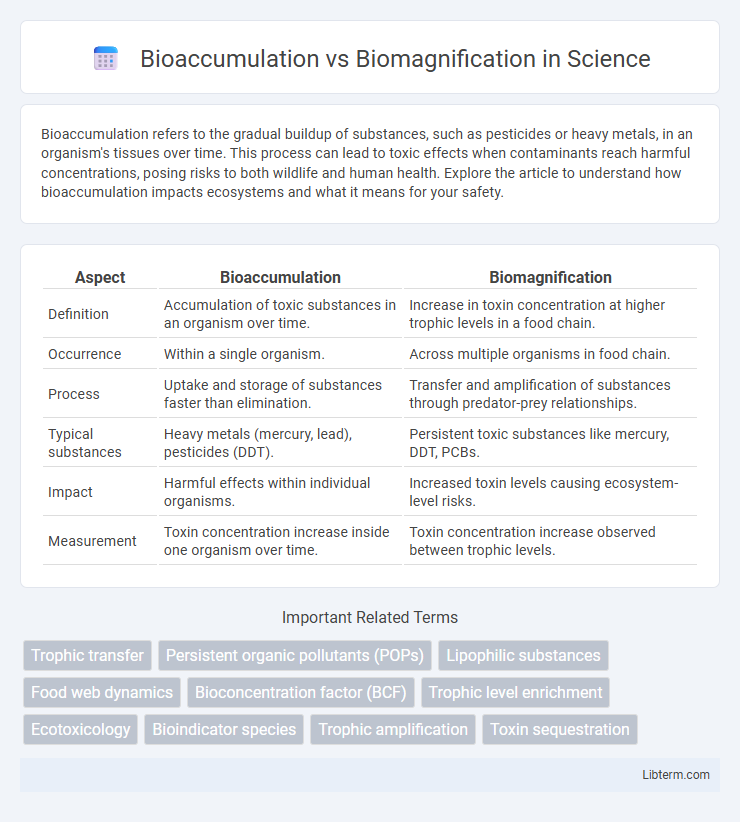Bioaccumulation refers to the gradual buildup of substances, such as pesticides or heavy metals, in an organism's tissues over time. This process can lead to toxic effects when contaminants reach harmful concentrations, posing risks to both wildlife and human health. Explore the article to understand how bioaccumulation impacts ecosystems and what it means for your safety.
Table of Comparison
| Aspect | Bioaccumulation | Biomagnification |
|---|---|---|
| Definition | Accumulation of toxic substances in an organism over time. | Increase in toxin concentration at higher trophic levels in a food chain. |
| Occurrence | Within a single organism. | Across multiple organisms in food chain. |
| Process | Uptake and storage of substances faster than elimination. | Transfer and amplification of substances through predator-prey relationships. |
| Typical substances | Heavy metals (mercury, lead), pesticides (DDT). | Persistent toxic substances like mercury, DDT, PCBs. |
| Impact | Harmful effects within individual organisms. | Increased toxin levels causing ecosystem-level risks. |
| Measurement | Toxin concentration increase inside one organism over time. | Toxin concentration increase observed between trophic levels. |
Introduction to Bioaccumulation and Biomagnification
Bioaccumulation refers to the gradual accumulation of substances, such as pesticides or heavy metals, in an organism's tissues over time due to direct exposure or ingestion. Biomagnification describes the increasing concentration of these toxic substances at successive trophic levels within a food chain, resulting in higher contaminant levels in predator species. Understanding both processes is crucial for assessing environmental pollution impacts on ecosystems and human health.
Defining Bioaccumulation
Bioaccumulation refers to the process by which organisms absorb and store toxic substances, such as heavy metals or pesticides, faster than they can eliminate them, leading to increased concentrations in their tissues over time. This phenomenon primarily occurs through direct exposure to contaminated environments or ingestion of polluted food. Bioaccumulation differs from biomagnification, which involves the progressive increase of toxin concentrations at higher levels of the food chain.
Defining Biomagnification
Biomagnification refers to the increasing concentration of toxic substances, such as heavy metals or pesticides, in organisms at higher trophic levels within a food chain. This process occurs as predators consume prey containing accumulated toxins, causing the pollutants to magnify in concentration as they move upward through successive levels. Unlike bioaccumulation, which involves toxin buildup within a single organism over time, biomagnification specifically describes the amplification of toxins across multiple organisms in an ecosystem.
Key Differences Between Bioaccumulation and Biomagnification
Bioaccumulation refers to the gradual buildup of toxic substances within an organism over time, while biomagnification describes the increase in toxin concentration as it moves up the food chain. Key differences include that bioaccumulation occurs within a single organism and is influenced by exposure duration, whereas biomagnification amplifies toxin levels across multiple trophic levels, affecting predators more severely. These processes impact ecosystems differently, with bioaccumulation affecting individual species' health and biomagnification posing greater risks to apex predators and humans.
Mechanisms of Bioaccumulation
Bioaccumulation occurs when organisms absorb toxic substances like heavy metals or pesticides faster than they can eliminate them, leading to increased concentrations in their tissues over time. This process involves direct uptake from the environment through skin, gills, or ingestion of contaminated food and water. Understanding bioaccumulation mechanisms is critical for assessing environmental risks and the long-term impact of pollutants on aquatic and terrestrial ecosystems.
Mechanisms of Biomagnification
Biomagnification occurs when toxic substances, such as persistent organic pollutants (POPs) or heavy metals, increase in concentration as they move up through trophic levels in a food chain. Organisms at each higher level consume multiple contaminated prey, leading to higher accumulation of toxins in their bodies compared to organisms at lower levels. This mechanism contrasts with bioaccumulation, which refers to the buildup of toxins within a single organism over time rather than across multiple levels of a food web.
Environmental Contaminants Involved
Bioaccumulation refers to the buildup of environmental contaminants like heavy metals (mercury, lead) and persistent organic pollutants (PCBs, DDT) within an organism's tissues over time. Biomagnification describes the increasing concentration of these toxic substances as they move up the food chain, affecting apex predators with the highest contaminant levels. Key contaminants involved include mercury in aquatic ecosystems and chlorinated pesticides that persist through trophic levels, posing significant ecological and health risks.
Ecological and Human Health Impacts
Bioaccumulation refers to the accumulation of toxic substances, such as heavy metals and persistent organic pollutants, in an organism over time, posing risks to individual health and reproductive success. Biomagnification describes the increasing concentration of these toxins as they move up the food chain, leading to elevated exposure for top predators and humans who consume contaminated fish and wildlife. Together, these processes contribute to ecosystem imbalances, biodiversity loss, and serious human health effects, including neurological disorders and cancers linked to pollutant exposure.
Case Studies and Real-World Examples
Mercury contamination in Minamata Bay, Japan, exemplifies bioaccumulation where methylmercury concentrated in fish tissue caused severe neurological damage in humans consuming the fish. In the Great Lakes, biomagnification of polychlorinated biphenyls (PCBs) led to higher toxic concentrations in top predators like lake trout and bald eagles, causing reproductive failures. Another case involves DDT in the 20th century, where biomagnification through the food chain resulted in eggshell thinning and population declines in birds of prey such as the peregrine falcon.
Prevention and Mitigation Strategies
Preventing bioaccumulation involves reducing the release of persistent organic pollutants (POPs) and heavy metals into ecosystems by enforcing strict regulations on industrial discharge and promoting green chemistry alternatives. Mitigation of biomagnification requires monitoring food chains, implementing habitat restoration projects, and promoting sustainable fishing practices to minimize toxin transfer through trophic levels. Public education on the dangers of chemical pollutants and encouraging the use of eco-friendly products further supports the reduction of both bioaccumulation and biomagnification impacts.
Bioaccumulation Infographic

 libterm.com
libterm.com